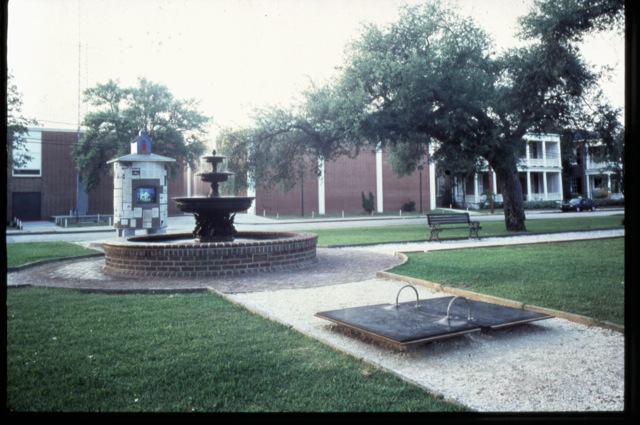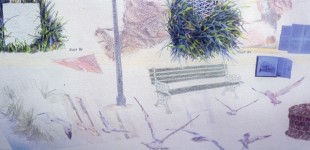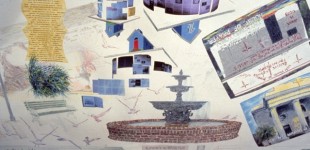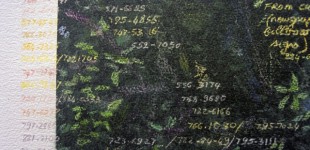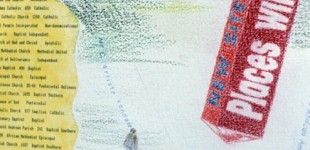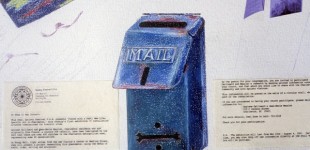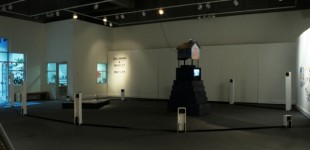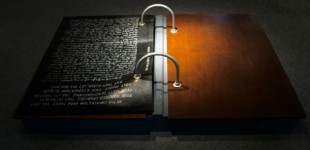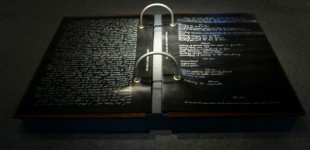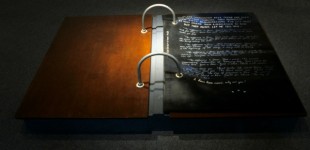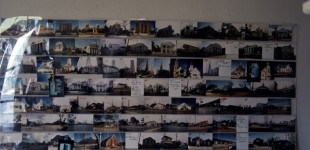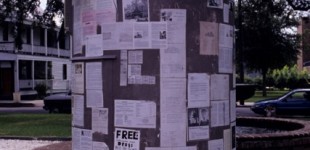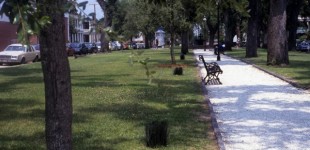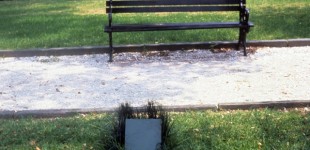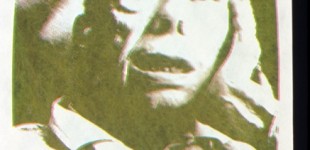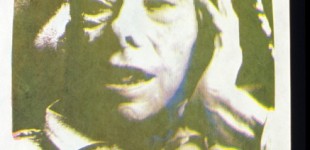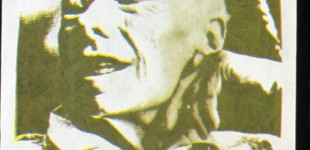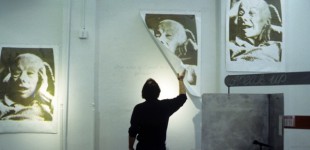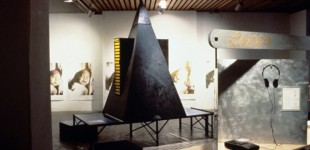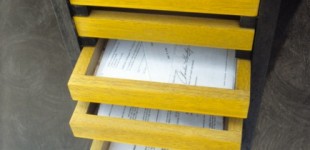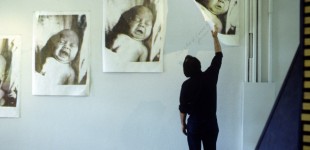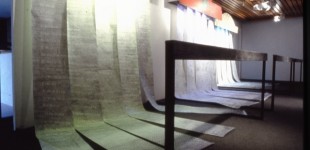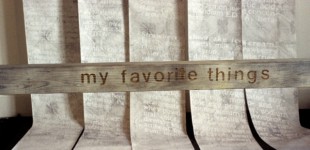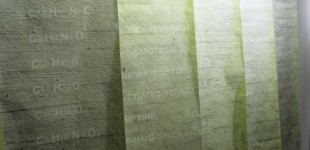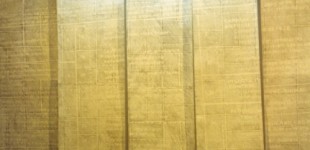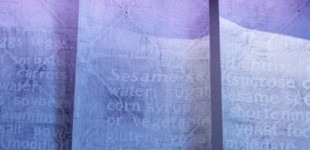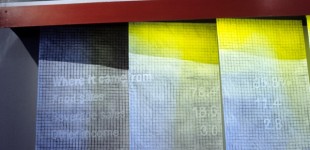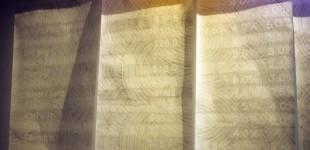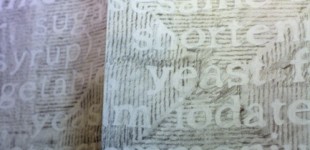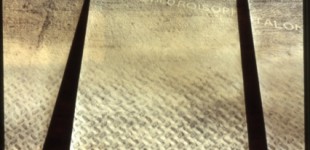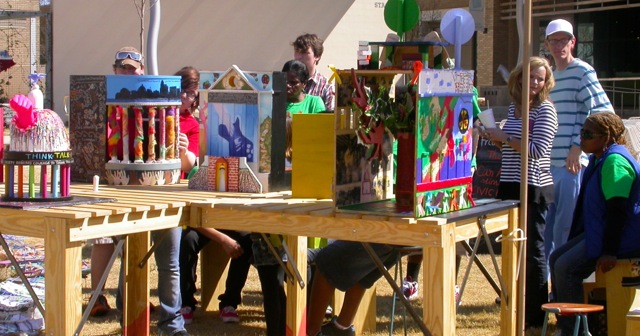PORTRAITS OF AMERICA is a series of three participatory installations: “Holy City”, “Insurance: Compassion For Sale” and “Fast-Food-Chain-Feeding.”
#1 Holy City
Wragg Mall, Charleston, SC 1991 (outdoor) – Elisabeth Harper Gallery, Presbyterian College, Clinton, SC 1994 (indoor)
This installation was first commissioned by Spoleto Festival USA, part of “Places with a Past: new site-specific art at Charleston’s Spoleto Festival”, curated by Mary-Jane Jacob. It includes sound, video, writings, printed matters, constructed elements and a mailbox.
Holy City deals with the fact that, in the Charleston area, there are more than 400 churches representing over 60 denominations.
The site in Charleston: a 500’ long and narrow grassy park lined with trees; two perpendicular alleys, in the shape of a cross; where the alleys meet, stands a fountain.
Sound: four, 12 minute tapes of a log of Charleston churches, sung in English, Gullah and French, in a musical mode best described by a critic as a mix of Gregorian chant and Rap.
Music comes from 8 speakers, concealed in the grass, positioned along the alleys so that passersby will be engulfed in a wave of changing tunes. Another tape, made of sounds of the city, comes out of the fountain.
Video: a 45 minute visual log of the churches of Charleston. From historic churches to store front praise houses, they represent, in random order, all faiths, races, classes and economic strata. HOLY CITY
Writings: as many questions about God and faith as there are churches in Charleston. Pseudo-answers found in church bulletin boards, yellow pages, roadside advertising.
All handwritten on the 3 1/2 X 4 foot, double entry. 1/4 inch thick rubber pages of a book , anchored in concrete. The whole thing looks like an oversize ring binder, held together by giant U-bolts. It takes two to turn the pages.
Construction: a Paris-like Morris column shelters a screen for the video and the hardware for the sound system. It is also used to post the printed material sent to us as an answer to our mailings, or deposited in the Mailbox, attached to the side. The model of a modest, dilapidated church stands on top of the structure.
HOLY CITY, A DOCUMENTARY DRAWING, by Gwylene Gallimard. 1991
Mixed media: color pencil, watercolor, spray paint, collages, varnishes. 14 1/2’ x 4 1/2’
It is a drawing meant to be walked around. Therefore the curved horizontal structure, as a pedestal for it.
Installation artists often feel a necessity to write about their work as a complement to photographs. I attempted here to use the means of visual communication to show the concept, the environment, the making and all the elements (including the full texts) that were part of this temporary installation.
PORTRAITS OF AMERICA
#2 Insurance: Compassion for Sale
Tula Foundation, Atlanta GA 1993 – Halsey Gallery, College of Charleston, SC 1994 – Walker’s Point Center for the Arts, Milwaukee, WI 1994
We did not gauge the importance, social and economic, of universal health coverage, such as the French model of the time, before we started living in the US. Personal and business situations forced us to face the problem. Yet, as artists, we had to keep a sense of distance and humor about it. We used irony to accomplish that.
This indoor installation includes sound, graphics, construction, writings, printed matters and a recording studio for viewers’ participation.
Sound: the continuous recitation of the names of insurance companies interweaves with sounds, texts and sketches, by male and female voices, in three languages: Gullah, French, English. All have to do with insurance, nightmares and dreams.
Graphics: two sets of 7 silkscreened images, Muybridge-like, from video stills. One set shows the face of an old woman as she moves her head from right to left and, in the process, develops a smile. The other is of the face of a young baby moving its head the same way, but developing a cry. Together, the series seem to define virtual boundaries, for life and anxiety.
Construction: A free interpretation of San Francisco’s TransAmerica Building sits in the center of the space, atop a platform. You may go up a ramp and access the 36 drawers tucked vertically into the building.
Writings: the drawers are filled with insurance documents, small prints from contracts, commentary around the topic of insurance, a 17 page free style poetry “Antigone Life” … Even compassion comes at a high price!
Recording and listening station: where one visitor can tape a story and another can listen. Episodes and comments around insurance.
PORTRAITS OF AMERICA
#3 Fast-Food-Chain-Feeding
Halsey Gallery, College of Charleston, SC 1994 – Walker’s Point Center for the Arts, Milwaukee, WI 1994
An attempt to look “behind the curtain” at one of America’s most American industries. Coming from French artists who had decided to open a small food enterprise in the US, to name it “Fast & French, Inc.” and to promote the social side of eating, such a project was a natural.
An indoor installation which includes video, drawings, constructed elements and printed matters.
The constructed elements: thin painted plywood cutouts in the shape and color of fast food restaurant gables. Attached to the walls, they are props which hold the drawings and carry different color fluorescent lighting fixtures. The light glows down, along the drawings and gives the space, which is kept dark, a mysterious hue. Also, five barrier-like structures, placed in front of every drawing protect the space and define the circulation patterns inside the room.
The drawings: five 8’X15’ pieces, each made of five vertical bands of white Ingres paper. Each piece is a text about the technology of fast food: chemistry, sanitation, finance … (“Food Industry: Food Additives”; “Food Production: Inspection report”; “Restaurant Industry Dollars”; “Franchised Restaurants: Basic Investments”; “My Favorite Things”) Rubbing the paper bands with graphite over repetitive relief patterns and writing “ in reverse”, with an eraser, so that the letters come out as white on black, is the technique chosen. The drawings hang, partly on the floor, from the five props.
The video: an adult reads to children from Margaret Mead’s writings on food, the anthropology of food, its universal, ritualistic, community-building qualities: there is more to food than eating. His voice carries softly throughout the installation. The screen is half-buried under a heap of disposable styrofoam boxes which contain a one-page text on transubstantiation: how industry has transformed food into money, gold really, through chemistry, management and advertising. Leon McKelvey, Margareth Mead and children
